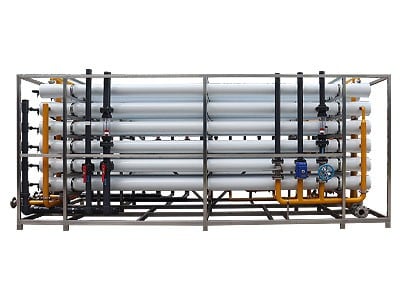Process-Reverse Osmosis Demineralization
CASE STUDY-SWRO


RO is the process of Osmosis in reverse. Osmosis occurs naturally without an external energy source, but reversing the osmosis process requires applying energy to the more saline solution to reverse the natural flow.
Reverse Osmosis Demineralization
Reverse Osmosis, commonly referred as RO, is a process where water is demineralised by flowing under pressure through a semi-permeable membrane.
To understand the purpose and process of Reverse Osmosis it is necessary to first understand the phenomenon of Osmosis.
Osmosis is a naturally occurring phenomenon in which a weaker saline solution will tend to migrate to a strong saline solution.
The figure 1 illustrates the phenomenon of the Osmosis. A semi-permeable membrane is placed between 2 compartments. Semi-permeable means that the membrane is permeable to some species and not permeable to others. In this case, the membrane is permeable to water molecules but not permeable to dissolved ions and other contaminants.
In order to reach the equilibrium (same concentration of salts in both sides of the membrane, fundamental rule of nature), the water will pass from the pure water compartment to the salt-containing compartment, to dilute the salt solution.
In Figure 1 you can also see a difference in height of solution on compartment of salt water and pure water. This height will increase until the pressure of the column of water (salt solution) is so high that the force of this water column stops the water flow. The equilibrium point of this water column height in terms of water pressure against the membrane is called osmotic pressure.
Figure 1 – Phenomenon of Osmosis
Reverse Osmosis
If we consider that we want to produce pure water from the salt water, it is necessary to apply a “force” (pressure) in the column of the salt-containing water, to force the water to flow in the reverse direction, making the water molecules to flow through the semi-permeable membranes to the fresh water compartment. This is the basis of the process called Reverse Osmosis (Figure 2).
The pressure applied has to overcome the osmotic pressure.
Figure 2 – Reverse Osmosis
When pressure is applied to the concentrate solution (Figure 2), the water molecules are forced to flow through the semi-permeable membrane (The contaminants are left behind, since the semi-permeable membrane is only permeable to water molecules and not permeable to ions and other contaminants)
How does reverse osmosis work?
In practice, reverse osmosis is applied as a crossflow filtration process.
A high pressure pump is used to increase the pressure on the salt side of the RO and force the water to flow across the semi-permeable membrane., leaving most part (approximately 95%-99%) of the dissolves salts behind the stream.
Within the membrane system, the feed water will be split into a low-saline product, called permeate, and a high saline solution, called concentrate, brine or reject stream (Figure 3).
Figure 3 – Simple reverse osmosis scheme
As the feed water enters the RO membrane under pressure (enough to overcome osmotic pressure), the water molecules pass through a semi-permeable membrane and the salts and other contaminants are not allowed to pass and are discharged through the concentrate stream, which goes to drain or can be fed back (totally or partially) into the feed water stream to be recycled through the RO system to save water or to solve hydraulic issues in the system.
What will RO remove from water?
Reverse osmosis is capable of removing dissolved salts (ions), particles, colloids, organics, bacteria and pyrogens from the water.
A RO membrane rejects contaminants based on their size and charge. Any contaminant that has a molecular weight greater than 180 Da is most likely rejected by a properly running RO system.
In addition, the bigger the ionic charge of the contaminant, the more likely it will be unable to pass through the RO membrane.
RO membranes do not remove gases like CO2 or O2. These gases are not highly ionized (charged) while they’re in solution and have a very low molecular weight
The water is electrically neutral, it means that the sum of cations equals the sum of anions when expressed as equivalents. This also happens with RO permeate, for each cation that passes through the membrane, an anion must pass through as well.
The permeate will always be electrical neutral, there will be a charge balance.
Applications of RO
Reverse osmosis is very effective in treating brackish (surface and ground), tap and sea water for both small and large applications.
Some examples of applications:
Municipal drinking water
Food and beverage industry
Agricultural irrigation
Industrial ultrapure water
Industrial process water
Waste water reuse
Power industry (boiler feed water, cooling towers)
Municipal/industrial water reuse
Households
Lenntech provides sustainable and complete solutions with RO technology, integrating it with the pre-treatment and post treatment necessary.
Our advantages
Engineered and custom designed solutions for unique solutions
Turn-key solutions including design, engineering, manufacturing, automation, installation, maintenance and training.
State-of-art technologies for effective water and wastewater treatment, recycling, reuse, and disposal.
Best on-line assistance and on-site service and support.
For more information or quotation, please contact us: Feedback Form or call us on +31 152 610 900
CCRO
Reverse osmosis membrane construction
Reverse osmosis performance
Reverse osmosis stage vs pass
Reverse Osmosis
Reverse Osmosis Membranes
Reference-projects







